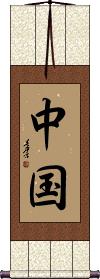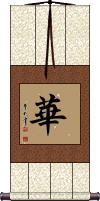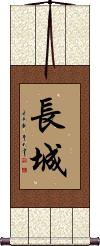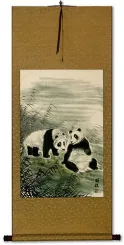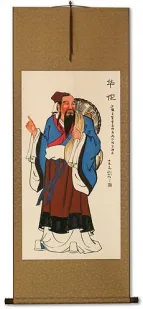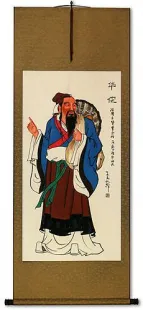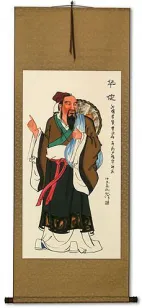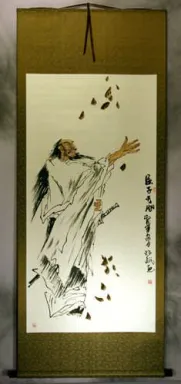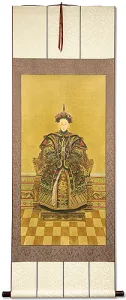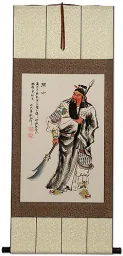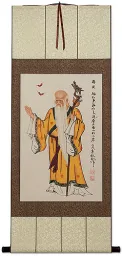Many custom options...
And formats...

China in Chinese / Japanese...
Buy a China calligraphy wall scroll here!
Personalize your custom “China” project by clicking the button next to your favorite “China” title below...
China
China
Flowers / Blooming / Splendid / China
華 means blooming flowers or splendid China.
華 is really open to interpretation. 華 meant flowers or blooming in ancient China. It still has that meaning in Japanese, and Buddhist contexts.
In modern China, this means glorious, beautiful, splendid, magnificent, or the best part of something. It can also refer to the country of China or something Chinese (such as people - overseas Chinese are often called “hua ren”). 華 is also a surname in China.
In Japanese, this can be the female given name “Ririka.” It's also the short name for a certain kind of playing cards in Japan.
In Korean, This can be the surname “Hwa.” While it also means splendid, flowery, or the country of China in Korean.
The Great Wall of China
The Great Wall of China
長城 is the Chinese name for the Great Wall.
Built at the northern border of China to protect from Mongol attack.
Notes:
In Japanese, this can be a surname Nagaki. Japanese often use a longer title for the Great Wall of China.
In Korean, this refers to Changsŏng (a city in Changsŏng-kun county, Chŏllanam-to province).
This in-stock artwork might be what you are looking for, and ships right away...
Gallery Price: $200.00
Your Price: $79.88
Gallery Price: $200.00
Your Price: $79.88
Gallery Price: $200.00
Your Price: $79.88
Gallery Price: $63.00
Your Price: $34.88
Gallery Price: $55.00
Your Price: $19.88
Gallery Price: $200.00
Your Price: $79.88
Empress Ancestor Of China
Print Wall Scroll
Discounted Blemished
Gallery Price: $200.00
Your Price: $79.88
Not the results for china that you were looking for?
Below are some entries from our dictionary that may match your china search...
| Characters If shown, 2nd row is Simp. Chinese |
Pronunciation Romanization |
Simple Dictionary Definition |
元 see styles |
yuán yuan2 yüan yuan ユアン |
More info & calligraphy: Won(kana only) (See 元・げん・3) yuan (monetary unit of China) (chi: yuán); (given name) Motoyasu Beginning, first, original, head; dollar; Mongol (dynasty). |
刀 see styles |
dāo dao1 tao tou / to とう |
More info & calligraphy: Katana(1) sword (esp. Japanese single-edged); katana; (2) (とう only) scalpel; (3) (とう only) (See 彫刻刀・ちょうこくとう) chisel; burin; graver; (4) (とう only) (See 刀銭) knife money (knife-shaped commodity money used in ancient China); (personal name) Tou sword |
吳 吴 see styles |
wú wu2 wu |
More info & calligraphy: Uy |
周 see styles |
zhōu zhou1 chou meguru めぐる |
More info & calligraphy: Chau(counter) (1) counter for laps or circuits; (2) {math} perimeter; (3) (hist) Zhou dynasty (of China; approx. 1046-256 BCE); Chou dynasty; (female given name) Meguru Around, on every side, complete. |
唐 see styles |
táng tang2 t`ang tang touzaki / tozaki とうざき |
More info & calligraphy: Ton(1) (hist) Tang dynasty (of China; 618-907); T'ang dynasty; (2) (archaism) China; foreign country; (surname) Touzaki for nothing |
塔 see styles |
tǎ ta3 t`a ta tousaki / tosaki とうさき |
More info & calligraphy: Ta(n,n-suf) (1) tower; steeple; spire; (2) (abbreviation) (original meaning) (See 卒塔婆・1,塔婆・1) stupa; pagoda; dagoba; (surname) Tousaki stūpa; tope; a tumulus, or mound, for the bones, or remains of the dead, or for other sacred relics, especially of the Buddha, whether relics of the body or the mind, e.g. bones or scriptures. As the body is supposed to consist of 84,000 atoms, Aśoka is said to have built 84,000 stūpas to preserve relics of Śākyamuni. Pagodas, dagobas, or towers with an odd number of stories are used in China for the purpose of controlling the geomantic influences of a neighbourbood. Also 塔婆; 兜婆; 偸婆; 藪斗波; 窣堵波; 率都婆; 素覩波; 私鍮簸, etc. The stūpas erected over relics of the Buddha vary from the four at his birthplace, the scene of his enlightenment, of his first sermon, and of his death, to the 84,000 accredited to Aśoka. |
家 see styles |
jiā jia1 chia chi ち |
More info & calligraphy: Family / Home(suffix) (colloquialism) (kana only) (See ん家) 's house; 's home; (surname) Karyū Family; home; school, sect; genus. |
梁 see styles |
liáng liang2 liang reon れおん |
More info & calligraphy: Leung(hist) Liang dynasty (of China; 502-557); (surname) Reon pillar |
洛 see styles |
luò luo4 lo Raku |
More info & calligraphy: LuoLuoyang 洛陽, the ancient capital of China. |
清 see styles |
qīng qing1 ch`ing ching seiji / seji せいじ |
More info & calligraphy: Clarity(hist) Qing dynasty (of China; 1644-1912); Ch'ing dynasty; Manchu dynasty; (personal name) Seiji |
秦 see styles |
qín qin2 ch`in chin yasushi やすし |
More info & calligraphy: Qin / Chin / Tan / Yasushi(hist) Qin dynasty (of China; 221-207 BCE); Ch'in dynasty; (surname) Yasushi a fine strain of rice |
簡 简 see styles |
jiǎn jian3 chien kan かん |
More info & calligraphy: Simplicity(1) (See 簡にして要を得る) (ant: 繁・1) simplicity; brevity; (2) letter; note; correspondence; (3) bamboo writing strip (in ancient China); (4) (abbreviation) (See 簡体字) simplified Chinese character; (surname) Kan A tablet, memorandum; to abridge; appoint; examine; abrupt, concise, direct. |
胡 see styles |
hú hu2 hu ko こ |
More info & calligraphy: Hu(hist) barbarian tribes surrounding ancient China; (surname) Fu; (surname) Hu How? Why? Hun; Turk; random; hemp; long-lived; pepper, etc.; translit. go, hu. |
華 华 see styles |
huá hua2 hua ka か |
More info & calligraphy: Flowers / Blooming / Splendid / China(1) flashiness; showiness; brilliance; splendor; (2) bloom; flowers; (3) (abbreviation) (See 中華民国・1) Republic of China; (female given name) Ririka kusuma; puṣpa; padma; a flower, blossom; flowery; especially the lotus; also 花, which also means pleasure, vice; to spend, waste, profligate. 華 also means splendour, glory, ornate; to decorate; China. |
賊 贼 see styles |
zéi zei2 tsei zoku ぞく |
More info & calligraphy: Rebel / Insurgent(1) thief; robber; burglar; (2) rebel; insurgent; traitor A thief, robber, spoiler; to rob, steal, etc. |
道 see styles |
dào dao4 tao wataru わたる |
More info & calligraphy: Daoism / Taoism(1) (abbreviation) (See 道・みち・1) road; path; street; route; (2) (See 道・みち・5) way; set of practices; rules for conducting oneself; (3) (abbreviation) (in Japanese schools) (See 道徳教育) moral education; (4) Buddhist teachings; (5) Taoism; (6) administrative region of Japan (Hokkaido); (7) (hist) administrative region of Japan (Tokaido, Tosando, etc.); (8) province (administrative region of Korea); (9) circuit (administrative region of China); (10) (hist) province (Tang-era administrative region of China); (personal name) Wataru mārga. A way, road; the right path; principle, Truth, Reason, Logos, Cosmic energy; to lead; to say. The way of transmigration by which one arrives at a good or bad existence; any of the six gati, or paths of destiny. The way of bodhi, or enlightenment leading to nirvāṇa through spiritual stages. Essential nirvāṇa, in which absolute freedom reigns. For the eightfold noble path v. 八聖道.; The two Ways: (1) (a) 無礙道 or 無間道 The open or unhindered way, or the way of removing all obstacles or intervention, i. e. all delusion; (b) 解脫道 the way of release, by realization of truth. (2) (a) 難行道 The hard way of "works", i. e. by the six pāramitā and the disciplines. (b) 易行道 the easy way salvation, by the invocation of Amitābha. (3) (a) 有漏道 The way of reincarnation or mortality; (b) 無漏 the enlightened way of escape from the miseries of transmigration. (4) (a) 教道 The way of instruction; (b) 證道 the way of realization. (5) The two lower excretory organs. |
金 see styles |
jīn jin1 chin kin きん |
More info & calligraphy: Gold / Metal(1) gold (metal); (2) (See 金色) gold (color); (3) gold (medal); first place (prize); (noun - becomes adjective with の) (4) something of great value; something golden (e.g. silence); (5) money; gold coin; (6) (written before an amount of money) sum (of money); (7) (abbreviation) (See 金曜) Friday; (n,ctr) (8) karat (measure of purity of gold); carat; (9) (See 五行・1) metal (fourth phase of Wu Xing); (10) (hist) Jin dynasty (of China; 1115-1234); Chin dynasty; Jurchen dynasty; (11) (abbreviation) {shogi} (See 金将) gold general; (12) (abbreviation) (colloquialism) (See 金玉) testicles; (surname) Kimu; Kim hiraṇya, 伊爛拏 which means cold, any precious metal, semen, etc.; or 蘇伐刺 suvarṇa, which means "of a good or beautiful colour", "golden", "yellow", "gold", "a gold coin", etc. The Chinese means metal, gold, money. |
陳 陈 see styles |
chén chen2 ch`en chen chan チャン |
More info & calligraphy: Tran(1) (hist) Chen (ancient Chinese state; approx. 1045-479 BCE); Ch'en; (2) (hist) Chen dynasty (of China; 557-589 BCE); Ch'en dynasty; (surname) Tran Arrange, marshal, spread, state; old, stale. |
魏 see styles |
wèi wei4 wei takashi たかし |
More info & calligraphy: Wei(1) (hist) (See 三国・2,曹魏) Wei (kingdom in China during the Three Kingdoms period; 220-266 CE); Cao Wei; (2) (hist) Wei (kingdom in China during the Warring States period; 403-225 BCE); (given name) Takashi |
齊 齐 see styles |
qí qi2 ch`i chi hitoshi ひとし |
More info & calligraphy: Uniform / Complete / Perfect / OrderQi (kingdom in China during the Spring and Autumn Period and the Period of the Warring States); Ch'i; (male given name) Hitoshi Even, level, equal, uniform; complete, perfect; equalize; tranquillize; alike; all; at the same time, altogether. |
三国 see styles |
mikuni みくに |
(1) three countries; (2) (hist) (See 魏・ぎ・1,蜀・しょく・2,呉・ご・3) Three Kingdoms (in China, 220 CE-280 CE); (3) (hist) (See 新羅・しらぎ,百済・くだら,高句麗・こうくり) Three Kingdoms (in Korea, 57 BCE-668 CE); (4) (archaism) Japan, China and India; Japan, Korea and China; the whole world; (p,s,f) Mikuni |
上海 see styles |
shàng hǎi shang4 hai3 shang hai shanhai シャンハイ |
More info & calligraphy: ShanghaiShanghai (China); (place-name) Shanghai (China) |
中国 see styles |
nakakuni なかくに |
More info & calligraphy: China |
中國 中国 see styles |
zhōng guó zhong1 guo2 chung kuo nakaguni なかぐに |
More info & calligraphy: China(surname) Nakaguni Madhyadesa. 中天 (中天竺); 中梵 The middle kingdom, i. e. Central North India, v. 中印. |
北京 see styles |
běi jīng bei3 jing1 pei ching pekin ペキン |
More info & calligraphy: BeijingBeijing (China); Peking; (place-name) Beijing (China); Peking |
南京 see styles |
nán jīng nan2 jing1 nan ching nankin なんきん |
More info & calligraphy: Nanjing(1) Nanjing (China); Nanking; (2) (ksb:) (See カボチャ) pumpkin; squash; (prefix noun) (3) Chinese; Southeast Asian; foreign; (prefix noun) (4) rare; precious; cute; (place-name) Nanking (China); Nanjing |
印度 see styles |
yìn dù yin4 du4 yin tu indo いんど |
More info & calligraphy: India(ateji / phonetic) (kana only) India; (place-name) India 印特伽; 身毒; 賢豆; 天竺 Indu (meaning 'moon' in Sanskrit), Hindu, Sindhu; see also 信度 and 閻浮 India in general. In the Tang dynasty its territory is described as extending over 90, 000 li in circuit, being bounded on three sides by the sea; north it rested on the Snow mountains 雪山, i. e. Himālayas; wide at the north, narrowing to the south, shaped like a half-moon; it contained over seventy kingdoms, was extremely hot, well watered and damp; from the centre eastwards to 震旦 China was 58, 000 li; and the same distance southwards to 金地國, westwards to 阿拘遮國, and northwards to 小香山阿耨達. |
司徒 see styles |
sī tú si1 tu2 ssu t`u ssu tu shito しと |
More info & calligraphy: Stu(hist) (See 六卿) Minister of Civil Administration and Social Welfare (Zhou dynasty China) |
司馬 司马 see styles |
sī mǎ si1 ma3 ssu ma shime しめ |
More info & calligraphy: Sima(hist) (See 六卿) Minister of War (Zhou dynasty China); (given name) Shime |
坐禪 坐禅 see styles |
zuò chán zuo4 chan2 tso ch`an tso chan zazen |
More info & calligraphy: Sit in MeditationTo sit in dhyāna, i.e. abstract meditation, fixed abstraction, contemplation; its introduction to China is attributed to Bodhidharma (though it came earlier), and its extension to Tiantai. |
Click here for more china results from our dictionary
The following table may be helpful for those studying Chinese or Japanese...
| Title | Characters | Romaji (Romanized Japanese) | Various forms of Romanized Chinese | |
| China | 中國 中国 | zhōng guó zhong1 guo2 zhong guo zhongguo | chung kuo chungkuo |
|
| China | 中國 中国 | chuu goku / chuugoku / chu goku | ||
| Flowers Blooming Splendid China | 華 华 | ririka | huá / hua2 / hua | |
| The Great Wall of China | 万里の長城 | ban ri no chou jou banrinochoujou ban ri no cho jo | ||
| The Great Wall of China | 長城 长城 | chou jou / choujou / cho jo | cháng chéng chang2 cheng2 chang cheng changcheng | ch`ang ch`eng changcheng chang cheng |
| In some entries above you will see that characters have different versions above and below a line. In these cases, the characters above the line are Traditional Chinese, while the ones below are Simplified Chinese. | ||||
Successful Chinese Character and Japanese Kanji calligraphy searches within the last few hours...

